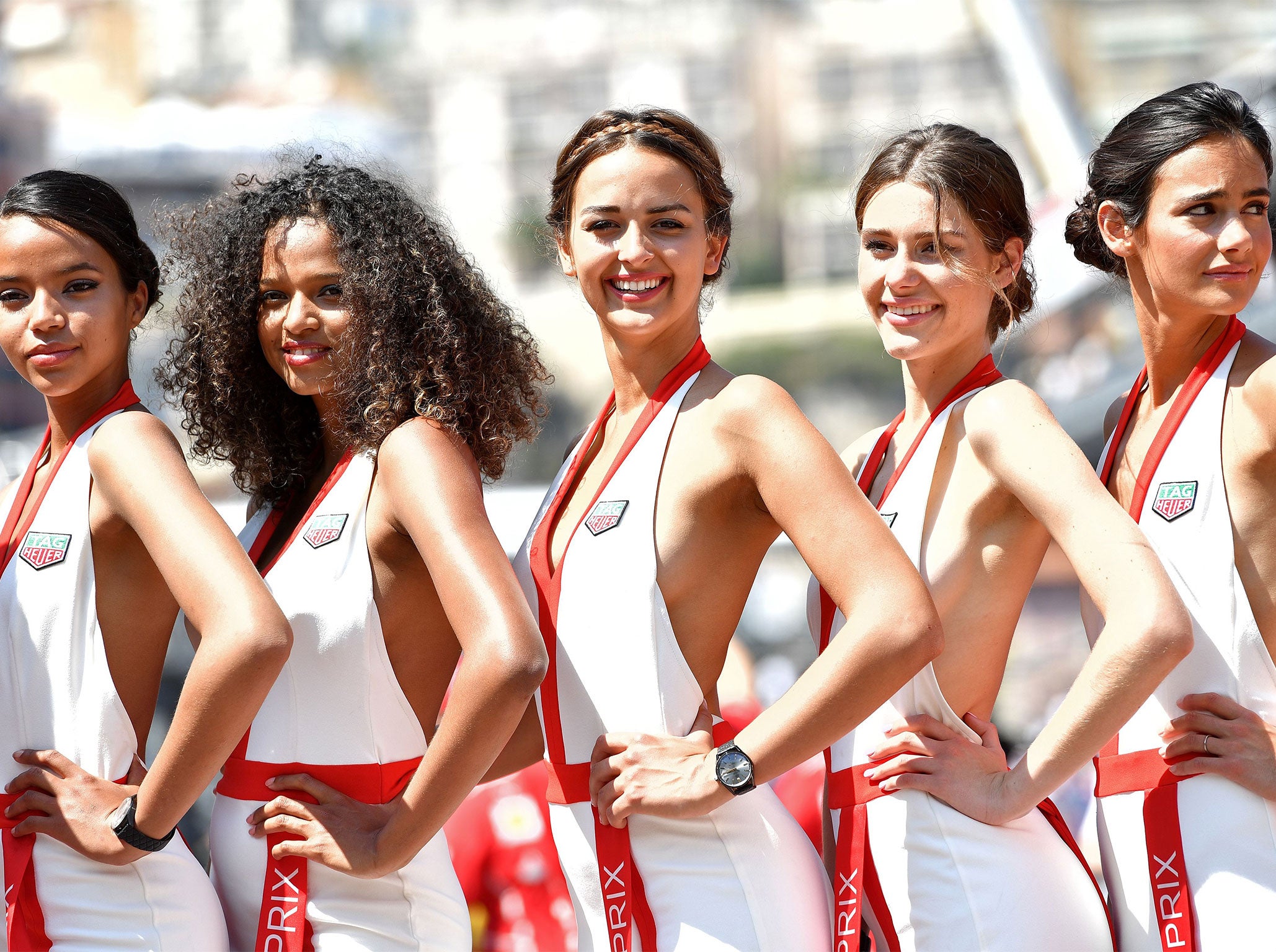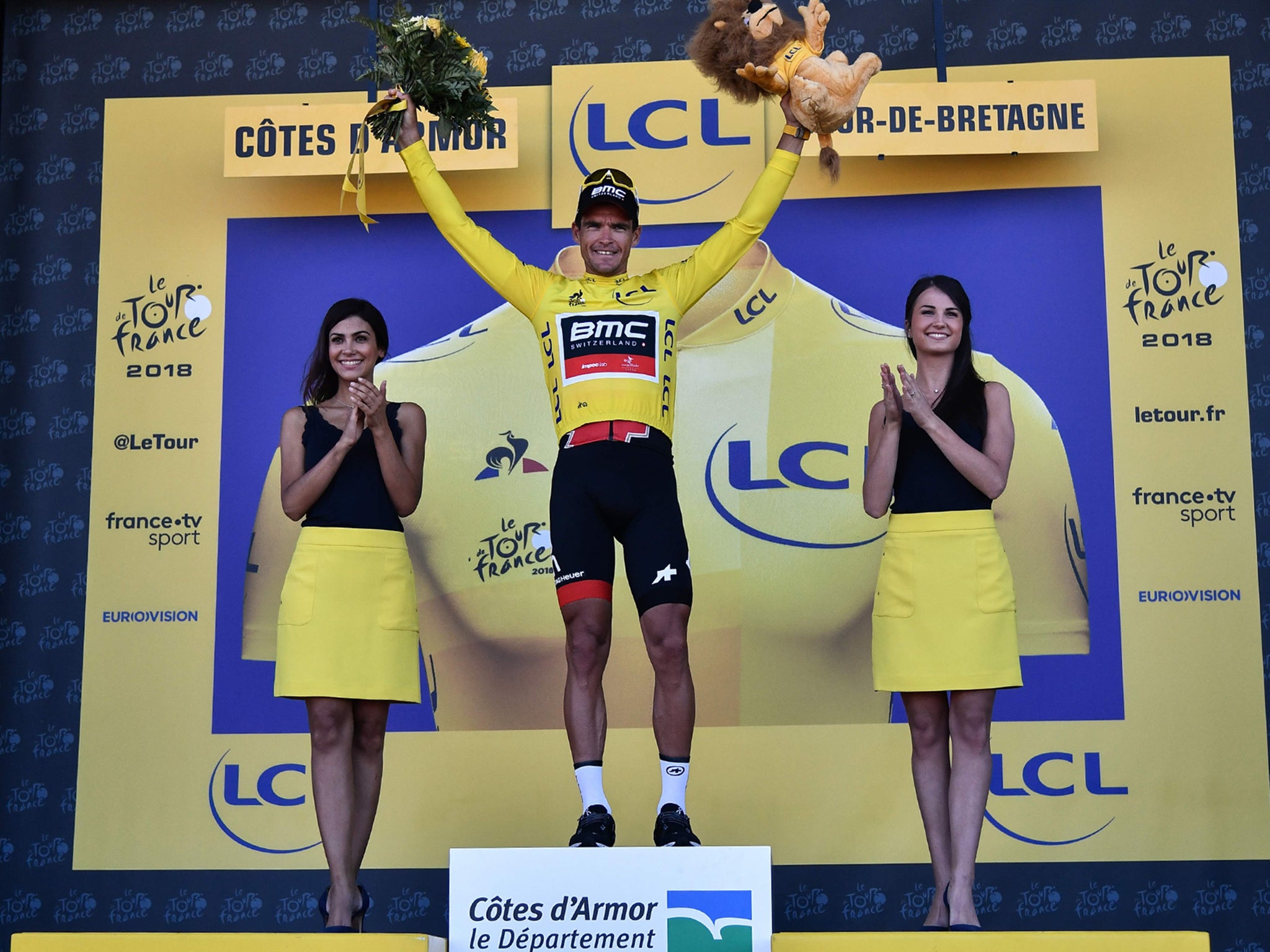The Independent's journalism is supported by our readers. When you purchase through links on our site, we may earn commission.
This is what happens when you try to take away podium girls from sports events in 2018
The Tour de France is retaining its podium girls, after Formula 1 dropped grid girls, and furious darts fans demanded the return of walk-on girls by insisting: 'Keep the ladies where they should be'
Your support helps us to tell the story
From reproductive rights to climate change to Big Tech, The Independent is on the ground when the story is developing. Whether it's investigating the financials of Elon Musk's pro-Trump PAC or producing our latest documentary, 'The A Word', which shines a light on the American women fighting for reproductive rights, we know how important it is to parse out the facts from the messaging.
At such a critical moment in US history, we need reporters on the ground. Your donation allows us to keep sending journalists to speak to both sides of the story.
The Independent is trusted by Americans across the entire political spectrum. And unlike many other quality news outlets, we choose not to lock Americans out of our reporting and analysis with paywalls. We believe quality journalism should be available to everyone, paid for by those who can afford it.
Your support makes all the difference.In cycling, it seems, it is business as usual.
The BBC may be using the men’s football World Cup to run trailers trumpeting its greatly increased coverage of women’s sport.
Fifa’s diversity boss may have ordered broadcasters to stop their cameras zooming in on “hot women” during matches at the World Cup.
But in cycling, it seems, there will be no restrictions on ogling, because the so-called “podium girls” are still appearing alongside – and kissing – the winner of every stage of the Tour de France.
The world’s most famous cycling event, it seems, is happy to continue a practice described by its critics as using women as “window dressing”.
Despite reports earlier this year that the Tour de France would stop the practice.
And despite the outrage that rocked cycling as long ago as 2013 when three-time road race world champion Peter Sagan was photographed theatrically pinching the bottom of podium hostess Maja Leye during the Tour of Flanders.

Amid the modern #MeToo movement and the confrontation of sexual harassment scandals like those surrounding Harvey Weinstein, it may initially seem strange that such apparent throwbacks to a 1970s world of “dolly birds” and casual sexism can still exist.
But exist they do, and any sport trying to change them can – still – expect to face a powerful backlash.
Here, in order of when the sports tried to change, or decided not to, is what is happening in 2018:
Darts – ‘keep the ladies where they should be’

By coincidence, the announcement came in the same week as the furore over the Presidents Club scandal, during which wealthy businessman were alleged to have groped and sexually harassed female hostesses working at a charity dinner billed as “the most un-PC event of the year”.
On January 27, the hitherto notoriously un-PC world of darts announced it would no longer be featuring “walk-on girls”, the young, attractive women who accompanied the male, sometimes not so attractive, players on to the stage.
An announcement from the Professional Darts Corporation (PDC) stated: “We regularly review all aspects of our events and this move has been made following feedback from our host broadcasters.”
Despite this coming four days after the breaking of the Presidents Club scandal, it was stated that the discussions leading up to the change had begun last year.
An ITV spokesperson added: “The decision was taken in consultation with ITV and we fully endorse this move.”
The broadcasters may have endorsed the move. The world of darts, or at least its most vocal components, did not.
Within hours, an online petition demanding the decision be reversed was on its way to gaining more than 48,000 signatures.
Former world champion Raymond van Barneveld urged his Twitter followers to sign too, writing: “I will really miss the girls!! For me they are a part of the darts.”
The leader of the Sheffield branch of the Women’s Equality Party did remind Barneveld that it was 2018, urging him to “wake up and smell the fact that these days are numbered”.
Most darts fans who commented online, however, seemed to side with the man who started the petition, David Shaw of Leighton Buzzard.
He had written: “Walk-on girls in darts has been traditional for years and so many things in this world that was tradition has been scrapped well this is one that should not be scrapped not only would we break tradition but women would be out of work also. [sic]”
The tone of many supporters was captured by one man who wrote: “The girls are part of an institution. Classy and glamorous, they are an integral part of the whole sport. Another f***kin PC decision by weak, lettuce leaf handshaking f***kin do-gooders. PDC weak, watch the fans revolt.”
“They are models for a reason,” argued another male supporter. “Why make them unemployed?”
“Keep the ladies where they should be,” he added, without any obvious sense of irony.
Perhaps bizarrely, Barry Hearn, the chairman of the PDC, seemed to side not with his own organisation, but with the petitioners.
Mr Hearn, who had pioneered the use of walk-on girls while trying to bring in his idea of showbiz razzmatazz after the PDC split from the British Darts Organisation in 1993, mourned the loss while chatting to talkSPORT radio host Alan Brazil.
“It’s out of my control,” said Mr Hearn, 70. “We’re living in changing times – the PC brigade, the liberal brigade, are out in strength and it’s causing changes in sport everywhere we look and it’s probably going to get worse.
“The girls are great, they get paid and it’s a job for them. But I do have a big problem in the age we live in – I’ve got the BBC, ITV and Sky, my three UK broadcasters, saying to me they do not want to show the walk-on girls on television
“They pump a huge amount of money into the sport. What am I supposed to do?”
In March Daniella Allfree, 30, told the Daily Star that 60 per cent of her income had come from being a darts walk-on girl.
“We’re being made to feel like we’ve been doing something shameful,” she said. “One of the feminists said we are like prostitutes.
“I don’t see myself as a vulnerable person, I see myself as a businesswoman who has made a really good career out of modelling.
“We are heavily involved in sport and now they are taking women out of sport. It’s the opposite to feminism – taking women’s jobs away.”
Her fellow former walk-on girl Charlotte Wood added: “It’s like everyone decided 2018 was the year you couldn’t be a glamorous woman any more. The world’s gone mad.”
But in April, Mr Shaw announced that his petition had failed to sway the broadcasters, and so, as he put it: “I’m afraid I have decided to allow the snowflakes to win.”
Formula 1 – changing, but not in Monaco and Russia, and not with the wholehearted support of its world champion

Four days after darts stopped using walk-on girls, Formula 1 announced the end of “grid girls”, the women who hold a sign showing the name of the driver and their number.
“We feel this custom does not resonate with our brand values and clearly is at odds with modern-day societal norms,” said Sean Bratches, managing director, commercial operations at Formula 1.
Perhaps it was significant that this change came the season after US company Liberty Media completed its $8bn (£6.4bn) takeover of Formula 1, wresting control from British former chief executive Bernie Ecclestone, 87, who had been in charge of the sport for nearly 40 years.
Some were supportive of the change. Melinda Messenger, the television presenter and former glamour model who worked as a grid girl at the start of her career, said: “It’s a sign that we’re heading in a really positive direction.
“I personally had a great time, I made some good money out of it, I had fun but really, looking back, essentially all I was there for was decoration, and I think that’s the issue.”
Beverley Turner, author of The Pits: the real world of Formula One, based on her experiences of reporting the sport for ITV, recalls: “The grid girls would be led out, a bit like prize cattle. They would have their bottoms pinched by the mechanics, there would be photographers sitting on the floor behind them, taking pictures of their bums, or up their skirts. They had to giggle and pretend that was OK.”
Franco-Swiss Formula 1 driver Romain Grosjean seemed to agree. Asked about the removal of the grid girls, he said: “I thought it was a good thing for women in the 21st century because they were not used as just a board holder.”
But Romain Grosjean is not world champion. Lewis Hamilton is, and the British driver was far more equivocal about the loss of grid girls.
When the Monaco Grand Prix organisers defied Liberty Media to announce they would allow grid girls – albeit only as representatives of sponsor Tag Heuer – Hamilton’s reaction was pointed.
“Thank you Jesus,” he wrote on social media, beneath a picture of five women in skin-tight jumpsuits with low necklines.
Although he later deleted the post, he told reporters: “Monaco is a very elegant grand prix and when we pull up to the grid and there’s beautiful women on the grid, that’s the Monaco Grand Prix and that’s a lovely thing.”
He did manage the caveat that: “I definitely don’t think we should ever be supporting or pushing these women to feel uncomfortable.”
Hamilton was backed by his fellow driver Sebastian Vettel.
“I agree with Lewis,” said the four-time world champion. “I like women. I think they look beautiful. The bottom line is that there is too much of a fuss nowadays.”
“The whole thing has been blown up, probably unnecessarily,” he added: “I don’t think any of the grid girls in the past were forced to do it. They enjoyed what they were doing.”
And indeed, that seemed to be the message coming from at least some of the grid girls themselves.
In February they organised a “Grid girls and promotion girls march through Birmingham”.
One of the marchers, former grid girl, model and, as it happened, ex-Presidents Club host Rachel Reid, 39, claimed to detect the influence of middle-class feminists in what was happening in Formula 1.
“It seems to be well off, if not privately educated then certainly middle class women, mostly based in London, telling working class women, many of whom are single parents in the provinces, what they can and can’t do,” she said. “For so-called feminists to be taking jobs from fellow women is so wrong. We have had years of men causing women trouble, now it is women attacking other women’s livelihoods.”
And on her attendance at eight President’s Club charity dinners, she added: “These events need pretty women to coax the money out these rich men.”
So far, Formula 1 seems to have weathered the dissent – but it may be about to face the might of Vladimir Putin’s Russia.
When the Monaco Grand Prix announced its intention to have grid girls in May, Dmitry Kozak, then the deputy prime minister of Russia and on the Russian Grand Prix organising committee, went on record as saying: “In all forms of motor sport there are girls advertising cars harmoniously and pleasantly.
“If we manage to reach agreement we plan to reinstate this tradition.
“After all, our girls are the most beautiful.”
The Sochi Grand Prix is in September.
Boxing – adding more ring girls
Having had a close view of the earlier controversies, given that his father Barry is chairman of the Professional Darts Corporation and he is one of the directors, leading boxing promoter Eddie Hearn told men’s magazine GQ what he planned to do in the fight game.
The group managing director of Matchroom Sport had no plans to ban the ring card girls who come on between rounds.
“Darts is shown on TV a lot and the truth is the walk-on girls aren’t really doing anything,” he explained. “Whereas the ring card girls are actually serving a purpose. And ring card girls have been a part of boxing history for many, many years.
“From a boxing point of view, we want to keep the traditions of the sport going.”
“It has nothing to do with sexism or feminism,” added Mr Hearn. “It is just a part of boxing and until we are told otherwise, we will keep them involved.
“Hopefully they will continue to be there in the future.”
It certainly looks like that will happen in boxing.
Speaking to the Daily Star in March, ex-darts walk-on girl Charlotte Wood explained how boxing was now helping fill the void in her work diary, thanks to boxing promoters like those who staged February’s fight between George Groves and Chris Eubank Jr: “The boxing promoters increased their ring girls from four to six in protest,” she said, “And I did the fight.”
Cycling – changing, but not at its most famous event

There have been changes.
Last year, Australia’s Tour Down Under and the Volta Catalunya both dispensed with the podium girls.
Then in July 2017 the Vuelta a España announced it would become the first cycling grand tour event to replace podium girls with “elegantly dressed” men and women.
“We are sensitive to the social media debate that has been generated about the presence of hostesses on podiums,” said Javier Guillén, the chief executive of Unipublic, the company that organises the Vuelta. “We cannot turn our backs on these concerns.”
For a while it even seemed that the biggest grand tour event of them all, the Tour de France, was also going to drop the podium girls.
In early March a report in The Times suggested the organisers of the Tour de France had held talks about the matter.
But when the tour started in Noirmoutier-en-l’Île this month, the podium girls were still there, and they have continued to be there at every subsequent stage.
For some, it was a disappointment.
“No one is forcing podium girls to be there,” wrote Twitter user and Bristol-based cycling enthusiast Julia Guinness, “But the view is pervasive that this is the only acceptable way women can engage in this sport. Is there a women’s tour? Do they get equal prize money? Does it get enough promotion?”
And, she could have added, it is not as if the issue of podium girls has been free of scandal.
In 2013, as Peter Sagan stood in second place at Oudenaarde during the Tour of Flanders, he watched Fabian Cancellara receive the “traditional” kiss from the two podium girls and seized the opportunity to grab the bottom of one of them, Maja Leye.
The outrage forced Sagan to apologise. Cycling, though, didn’t seem to change all that much.
Two years later, again in Flanders, the organisers of a women’s race thought it would be a good idea to flank the podium full of victorious female competitors with four women in high heels and bikinis.
Perhaps then, the Tour de France’s decision to stick with podium girls shouldn’t come as a huge surprise.
In 2010 when Christian Prudhomme, the director of the Tour de France, was explaining to The New York Times how he was getting more women involved in the organisation of the event, he said he had chosen Claire Pedrono for the prestigious job of managing the race blackboard.
“I felt like she deserved that honour because of her accomplishments as a cyclist,” said Mr Prudhomme. But he couldn’t resist adding: “I have to be honest with you, it also doesn’t hurt that she has a nice smile.”
Mr Prudhomme, of course, remains director of the Tour de France. And the official account of the hôtesses du Tour, as they are called in France, is still retweeting the words of Peter Sagan, presumably because they are happy with his apology to Maja Leye.
Perhaps, then, Mauro Vegni, race director of the Giro d’Italia, had after all been rather prescient in March when he dismissed the possibility of the Tour de France ditching podium girls as the fleeting symptom of “a temporary trend”.
At about the same time Welsh cyclist Luke Rowe had told the website Cycling Central: “They’ve always been there; it’s quite an historic thing when you go on the podium, you get a kiss off a podium girl. I think the whole sexist thing around the world has gone a bit crazy, everything is growing out of proportion.”
Mr Rowe is now competing in his fourth consecutive Tour de France, and on Twitter male cycling fans have been welcoming the continued presence of podium girls by arguing that this is a “solid gig for an aspiring model”.
It was, one happy American man assured us, “Properly classy all the time”.

Join our commenting forum
Join thought-provoking conversations, follow other Independent readers and see their replies
Comments